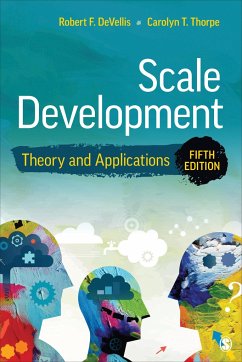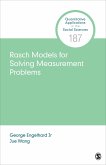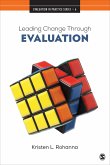Robert F. DeVellis (The University of North Carolina at Chapel Hill, Carolyn T. Thorpe ( The University of North Carolina at Chapel Hill
Scale Development
Theory and Applications
Robert F. DeVellis (The University of North Carolina at Chapel Hill, Carolyn T. Thorpe ( The University of North Carolina at Chapel Hill
Scale Development
Theory and Applications
- Broschiertes Buch
- Merkliste
- Auf die Merkliste
- Bewerten Bewerten
- Teilen
- Produkt teilen
- Produkterinnerung
- Produkterinnerung
Scale Development: Theory and Applications, by Robert F. DeVellis and new co-author Carolyn T. Thorpe, demystifies measurement by emphasizing a logical rather than strictly mathematical understanding of concepts. The Fifth Edition includes a new chapter that lays out the key concepts that distinguish indices from scales.
Andere Kunden interessierten sich auch für
![Test Development and Validation Test Development and Validation]() Gary Edward Edward Skaggs (USA Virginia Tech)Test Development and Validation162,99 €
Gary Edward Edward Skaggs (USA Virginia Tech)Test Development and Validation162,99 €![Rasch Models for Solving Measurement Problems Rasch Models for Solving Measurement Problems]() Engelhard, George, Jr.Rasch Models for Solving Measurement Problems49,99 €
Engelhard, George, Jr.Rasch Models for Solving Measurement Problems49,99 €![Qualitative Inquiry and Research Design Qualitative Inquiry and Research Design]() John W. Creswell (University of Mich Department of Family MedicineQualitative Inquiry and Research Design121,99 €
John W. Creswell (University of Mich Department of Family MedicineQualitative Inquiry and Research Design121,99 €![Developing Theory Through Qualitative Inquiry Developing Theory Through Qualitative Inquiry]() Johnny SaldanaDeveloping Theory Through Qualitative Inquiry64,99 €
Johnny SaldanaDeveloping Theory Through Qualitative Inquiry64,99 €![Analyzing Textual Information Analyzing Textual Information]() Johannes LedolterAnalyzing Textual Information49,99 €
Johannes LedolterAnalyzing Textual Information49,99 €![Completing Your Qualitative Dissertation Completing Your Qualitative Dissertation]() Linda Dale BloombergCompleting Your Qualitative Dissertation111,99 €
Linda Dale BloombergCompleting Your Qualitative Dissertation111,99 €![Leading Change Through Evaluation Leading Change Through Evaluation]() Kristen L. RohannaLeading Change Through Evaluation49,99 €
Kristen L. RohannaLeading Change Through Evaluation49,99 €-
-
-
Scale Development: Theory and Applications, by Robert F. DeVellis and new co-author Carolyn T. Thorpe, demystifies measurement by emphasizing a logical rather than strictly mathematical understanding of concepts. The Fifth Edition includes a new chapter that lays out the key concepts that distinguish indices from scales.
Hinweis: Dieser Artikel kann nur an eine deutsche Lieferadresse ausgeliefert werden.
Hinweis: Dieser Artikel kann nur an eine deutsche Lieferadresse ausgeliefert werden.
Produktdetails
- Produktdetails
- Verlag: SAGE Publications Inc
- 5 Revised edition
- Seitenzahl: 320
- Erscheinungstermin: 13. November 2021
- Englisch
- Abmessung: 231mm x 152mm x 18mm
- Gewicht: 486g
- ISBN-13: 9781544379340
- ISBN-10: 154437934X
- Artikelnr.: 61998436
- Herstellerkennzeichnung
- Libri GmbH
- Europaallee 1
- 36244 Bad Hersfeld
- gpsr@libri.de
- Verlag: SAGE Publications Inc
- 5 Revised edition
- Seitenzahl: 320
- Erscheinungstermin: 13. November 2021
- Englisch
- Abmessung: 231mm x 152mm x 18mm
- Gewicht: 486g
- ISBN-13: 9781544379340
- ISBN-10: 154437934X
- Artikelnr.: 61998436
- Herstellerkennzeichnung
- Libri GmbH
- Europaallee 1
- 36244 Bad Hersfeld
- gpsr@libri.de
Robert F. DeVellis is Professor Emeritus in the Department of Health Behavior (Gillings School of Global Public Health) at the University of North Carolina at Chapel Hill. Dr. DeVellis has more than 40 years of experience in the measurement of psychological and social variables. He served as the first domain chair for Social Outcomes of the Patient-Reported Outcomes Measurement Information System (PROMIS) consortium, a multisite National Institutes of Health (NIH) Roadmap initiative directed at identifying, modifying, testing, and disseminating outcome measures for use by NIH investigators. He has served on the Board of Directors for the American Psychological Association's Division of Health Psychology (38), on the Arthritis Foundation's Clinical/Outcomes/Therapeutics Research Study Section, and on the Advisory Board of the Veterans Affairs Measurement Excellence Initiative. He is the recipient of the 2005 Distinguished Scholar Award from the Association of Rheumatology Health Professionals and is an associate editor of Arthritis Care and Research. In addition, he has served as guest editor, guest associate editor, or reviewer for more than two dozen other journals. He has served as principal investigator or co-investigator since the early 1980s on a series of research projects funded by the federal government and private foundations.
Preface Acknowledgments About the Authors Chapter 1
Overview General Perspectives on Measurement Historical Origins of Measurement in Social Science Later Developments in Measurement The Role of Measurement in the Social Sciences Summary and Preview Exercises Chapter 2
Understanding the Latent Variable Constructs Versus Measures Latent Variable as the Presumed Cause of Scale Item Values Path Diagrams Further Elaboration of the Measurement Model Parallel Tests Alternative Models Choosing a Causal Model Exercises Note Chapter 3
Scale Reliability Methods Based on the Analysis of Variance Continuous Versus Dichotomous Items Internal Consistency Coefficient Alpha Remedies to Alpha's Limitations Coefficient Omega (?) Reliability Based on Correlations Between Scale Scores Reliability and Statistical Power Generalizability Theory Summary Exercises Notes Chapter 4
Scale Validity Content Validity Criterion-Related Validity Construct Validity What About Face Validity? Exercises Chapter 5
Guidelines in Scale Development Step 1: Determine Clearly What It Is You Want to Measure Step 2: Generate an Item Pool Step 3: Determine the Format for Measurement Step 4: Have Initial Item Pool Reviewed by Experts Step 5: Cognitive Interviewing Step 6: Consider Inclusion of Validation Items Step 7: Administer Items to a Development Sample Step 8: Evaluate the Items Step 9: Optimize Scale Length Exercises Note Chapter 6
Factor Analysis Overview of Factor Analysis Conceptual Description of Factor Analysis Bifactor and Hierarchical Factor Models Interpreting Factors Principal Components Versus Common Factors Confirmatory Factor Analysis Using Factor Analysis in Scale Development Sample Size Conclusion Exercises Chapter 7
The Index How an Index Differs From a Scale Rules of Thumb for Differentiating an Index From a Scale Is It a Scale or an Index? Formal Methods for Distinguishing Effect and Causal Indicators Steps in Developing and Evaluating an Index Hybrid Measures Methods Based on Structural Equation Modeling Criticisms of Index Composites Exercises Note Chapter 8
An Overview of Item Response Theory Item Difficulty Item Discrimination Guessing, or False Positives Item-Characteristic Curves IRT Applied to Multiresponse Items Exercises Chapter 9
Measurement in the Broader Research Context Before Scale Development After Scale Administration Final Thoughts Exercise References
Overview General Perspectives on Measurement Historical Origins of Measurement in Social Science Later Developments in Measurement The Role of Measurement in the Social Sciences Summary and Preview Exercises Chapter 2
Understanding the Latent Variable Constructs Versus Measures Latent Variable as the Presumed Cause of Scale Item Values Path Diagrams Further Elaboration of the Measurement Model Parallel Tests Alternative Models Choosing a Causal Model Exercises Note Chapter 3
Scale Reliability Methods Based on the Analysis of Variance Continuous Versus Dichotomous Items Internal Consistency Coefficient Alpha Remedies to Alpha's Limitations Coefficient Omega (?) Reliability Based on Correlations Between Scale Scores Reliability and Statistical Power Generalizability Theory Summary Exercises Notes Chapter 4
Scale Validity Content Validity Criterion-Related Validity Construct Validity What About Face Validity? Exercises Chapter 5
Guidelines in Scale Development Step 1: Determine Clearly What It Is You Want to Measure Step 2: Generate an Item Pool Step 3: Determine the Format for Measurement Step 4: Have Initial Item Pool Reviewed by Experts Step 5: Cognitive Interviewing Step 6: Consider Inclusion of Validation Items Step 7: Administer Items to a Development Sample Step 8: Evaluate the Items Step 9: Optimize Scale Length Exercises Note Chapter 6
Factor Analysis Overview of Factor Analysis Conceptual Description of Factor Analysis Bifactor and Hierarchical Factor Models Interpreting Factors Principal Components Versus Common Factors Confirmatory Factor Analysis Using Factor Analysis in Scale Development Sample Size Conclusion Exercises Chapter 7
The Index How an Index Differs From a Scale Rules of Thumb for Differentiating an Index From a Scale Is It a Scale or an Index? Formal Methods for Distinguishing Effect and Causal Indicators Steps in Developing and Evaluating an Index Hybrid Measures Methods Based on Structural Equation Modeling Criticisms of Index Composites Exercises Note Chapter 8
An Overview of Item Response Theory Item Difficulty Item Discrimination Guessing, or False Positives Item-Characteristic Curves IRT Applied to Multiresponse Items Exercises Chapter 9
Measurement in the Broader Research Context Before Scale Development After Scale Administration Final Thoughts Exercise References
Preface Acknowledgments About the Authors Chapter 1
Overview General Perspectives on Measurement Historical Origins of Measurement in Social Science Later Developments in Measurement The Role of Measurement in the Social Sciences Summary and Preview Exercises Chapter 2
Understanding the Latent Variable Constructs Versus Measures Latent Variable as the Presumed Cause of Scale Item Values Path Diagrams Further Elaboration of the Measurement Model Parallel Tests Alternative Models Choosing a Causal Model Exercises Note Chapter 3
Scale Reliability Methods Based on the Analysis of Variance Continuous Versus Dichotomous Items Internal Consistency Coefficient Alpha Remedies to Alpha's Limitations Coefficient Omega (?) Reliability Based on Correlations Between Scale Scores Reliability and Statistical Power Generalizability Theory Summary Exercises Notes Chapter 4
Scale Validity Content Validity Criterion-Related Validity Construct Validity What About Face Validity? Exercises Chapter 5
Guidelines in Scale Development Step 1: Determine Clearly What It Is You Want to Measure Step 2: Generate an Item Pool Step 3: Determine the Format for Measurement Step 4: Have Initial Item Pool Reviewed by Experts Step 5: Cognitive Interviewing Step 6: Consider Inclusion of Validation Items Step 7: Administer Items to a Development Sample Step 8: Evaluate the Items Step 9: Optimize Scale Length Exercises Note Chapter 6
Factor Analysis Overview of Factor Analysis Conceptual Description of Factor Analysis Bifactor and Hierarchical Factor Models Interpreting Factors Principal Components Versus Common Factors Confirmatory Factor Analysis Using Factor Analysis in Scale Development Sample Size Conclusion Exercises Chapter 7
The Index How an Index Differs From a Scale Rules of Thumb for Differentiating an Index From a Scale Is It a Scale or an Index? Formal Methods for Distinguishing Effect and Causal Indicators Steps in Developing and Evaluating an Index Hybrid Measures Methods Based on Structural Equation Modeling Criticisms of Index Composites Exercises Note Chapter 8
An Overview of Item Response Theory Item Difficulty Item Discrimination Guessing, or False Positives Item-Characteristic Curves IRT Applied to Multiresponse Items Exercises Chapter 9
Measurement in the Broader Research Context Before Scale Development After Scale Administration Final Thoughts Exercise References
Overview General Perspectives on Measurement Historical Origins of Measurement in Social Science Later Developments in Measurement The Role of Measurement in the Social Sciences Summary and Preview Exercises Chapter 2
Understanding the Latent Variable Constructs Versus Measures Latent Variable as the Presumed Cause of Scale Item Values Path Diagrams Further Elaboration of the Measurement Model Parallel Tests Alternative Models Choosing a Causal Model Exercises Note Chapter 3
Scale Reliability Methods Based on the Analysis of Variance Continuous Versus Dichotomous Items Internal Consistency Coefficient Alpha Remedies to Alpha's Limitations Coefficient Omega (?) Reliability Based on Correlations Between Scale Scores Reliability and Statistical Power Generalizability Theory Summary Exercises Notes Chapter 4
Scale Validity Content Validity Criterion-Related Validity Construct Validity What About Face Validity? Exercises Chapter 5
Guidelines in Scale Development Step 1: Determine Clearly What It Is You Want to Measure Step 2: Generate an Item Pool Step 3: Determine the Format for Measurement Step 4: Have Initial Item Pool Reviewed by Experts Step 5: Cognitive Interviewing Step 6: Consider Inclusion of Validation Items Step 7: Administer Items to a Development Sample Step 8: Evaluate the Items Step 9: Optimize Scale Length Exercises Note Chapter 6
Factor Analysis Overview of Factor Analysis Conceptual Description of Factor Analysis Bifactor and Hierarchical Factor Models Interpreting Factors Principal Components Versus Common Factors Confirmatory Factor Analysis Using Factor Analysis in Scale Development Sample Size Conclusion Exercises Chapter 7
The Index How an Index Differs From a Scale Rules of Thumb for Differentiating an Index From a Scale Is It a Scale or an Index? Formal Methods for Distinguishing Effect and Causal Indicators Steps in Developing and Evaluating an Index Hybrid Measures Methods Based on Structural Equation Modeling Criticisms of Index Composites Exercises Note Chapter 8
An Overview of Item Response Theory Item Difficulty Item Discrimination Guessing, or False Positives Item-Characteristic Curves IRT Applied to Multiresponse Items Exercises Chapter 9
Measurement in the Broader Research Context Before Scale Development After Scale Administration Final Thoughts Exercise References








